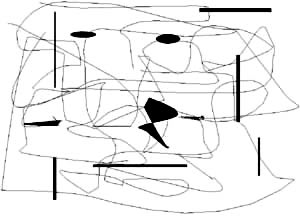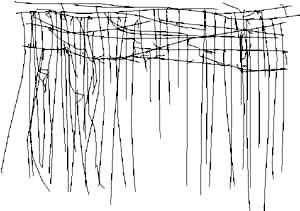In the scribble drawing Chaotic Faces it is fairly easy to see a frontal face and several profile views of human faces. This tendency to impose meaning on a somewhat chaotic visual array has been called the perceptual imperative. It is an example of the active nature of perception. For a fuller discussion see The Language of Visual Art (1989, Holt, Rinehart and Winston, Inc.) by J. F. Meyers. Faces seem to be particularly important stimuli. If some essential elements of a face, such as the eyes, nose or mouth, are suggested in an otherwise meaningless visual array, there will be a tendency to impose the idea of a face on the perception of the array. Of course other objects might be found as well. With further looking you might see some tree or flower forms suggested by the line patterns, although the face still seems to be a dominant feature.

"Chaotic Faces" by George K. Shortess
However, because perception is so automatic we sometimes think of it as a passive process. The stimulus energies from the world strike our receptive surfaces and we perceive the world around us. For example, light energy strikes the retina or mechanical vibrations move the organ of corti in the ear, and we simply see or hear what is out there in reality. And while that is true as far as it goes, it is very incomplete. Perception is also an active process of seeking out meaning in the stimulus array.
We accomplish this active interaction with the environment in a number of ways and at a number of different levels. At one level, the vast array of neural responses to the energy in the environment interacts in exceedingly complex ways in the nervous system, resulting in the selection and organization of these signals into meaningful representations of the perceived external environment. This perception is very closely driven by the stimulus input when we are looking intently at an object. At other times it is very loosely associated with external stimulation as in dreams. For further reading about the functioning nervous system, a number of good books are available. One recent text is Neuroscience: Exploring the Brain (1996, Williams & Wilkins) by M. F. Bear, B. W. Connors and M. A. Paradiso.
At a second level, we recognize that these perceptual processes, based in neural activity, direct our behavior such as movements of the eyes, head or whole body to get a better look at the world or to ignore certain inputs. Eye movements are the search engines for visual perception. Evidence from many eye movement studies shows that the eyes tend to focus on areas of high information content. This is clear in the early work by Buswell and later by Yarbus. A more recent discussion of the role of eye movements in the perception of art can be found in the journal Leonardo: C. F. Nodine, P. J. Locher and E. A. Krupinski (1993), The Role of Formal Art Training on Perception and Aesthetic Judgement of Art Compositions, vol. 26, pp. 219-227. So while we typically do create a world based in a common perception of reality, we are selective and each of us can pay attention to different aspects of the same environment. There is not complete relativism in our perceptions, but there are processes of selection and interpretation that we bring to the situation. In this sense, each person's perception involves both elements common to everyone in the situation and elements that are uniquely his or her own. This relationship and interaction between our inner perceptual processes and external reality have been a major focus of my art work over the past 15-20 years. The emerging technologies of computers and electronic music have provided the tools that have allowed me to develop interactive installations and environments that speak to the fundamental questions of how and why we experience a world with a self that is simultaneously involved and detached. This kind of art makes use of the computer as a tool in which viewers manipulate the environment and are partners with the artist in creating aesthetic experiences.
To illustrate, I will describe a recent piece, Doorways of Meaning, which was shown at the Rene Blouin Galerie in Montreal, Quebec, Canada and as part of the 25th Juried Show at the Allentown Art Museum, Allentown, PA. An impression of the view in the gallery is provided in the illustration. It has a very organic look. In Montreal, the gallery was approximately 16 feet wide and 20 feet long. It was hung with red and green cord networks, forming spaces that allowed people to move throughout the room creating doorways among the cords as they went. Around the boundary between the floor and the walls were eight photocells embedded in shredded paper. Light from red and green spotlights in the ceiling shone on the photocells. Viewers moving in the room cast shadows on the photocells and changed their resistances. The microcomputer was continually monitoring the photocells. When changes occurred, it was programmed to send MIDI signals to a sampler, a drum machine and a synthesizer. The audio outputs from these devices were then mixed and played through the speakers in the room. The sampler was loaded with eight voice samples that spoke to the nature of experience and the metaphor of doorways as the interfaces between inner experiences and external reality. Half of the voice samples were in English and half were in French, as a tribute to the bilingual city of Montreal. Half were male and half were female. In Allentown the arrangements were similar except that the room was 11.5 feet wide and 28.5 feet long. The photocells were mounted on a built-in shelf that was about 2.5 feet above the floor and were activated by light from the ceiling that was reflected from the walls. Also, all the voice samples were in English.
In both installations, people moved around and through the cords, creating shadows on the walls and individual patterns of voice, percussion and electronic music. For example, by moving rapidly, a babel of sound could be created which could fade out to a single voice when the viewer stopped. Some people varied their speed and moved their arms. Others moved very slowly and meditated. While all seemed to understand that their movements caused the sounds, several tried to work out certain regularities in the pattern and tried to understand how it worked. Some expressed the belief that moving the cords caused the sound. Others seemed to just accept the relationships between movement and sound, and developed their own expressive experience. Some found areas and movements that were relaxing, while others found a resolution in the auditory activity that they generated in special places in the installation.

"Impressions of Doorways of Meaning"
by George K. Shortess
Perceptually they were drawn into a somewhat chaotic environment. In this situation they began to try to organize and make sense of the confusing situation, an example of the perceptual imperative. Because of the complexity and ambiguity of both the visual and auditory stimulation, it was more difficult than seeing a face in Chaotic Faces. The content of the piece is the process of creative engagement by the viewers. In one very real sense the physical object is not the work of art. It is only an environment in which a work of art can occur. The perceptual, cognitive and emotional processes taking place in the viewers are the works of art. This is a challenge for the traditional approach to art, since the work becomes much less accessible when it resides within the viewer rather than on a gallery wall. But that is a topic for another discussion.